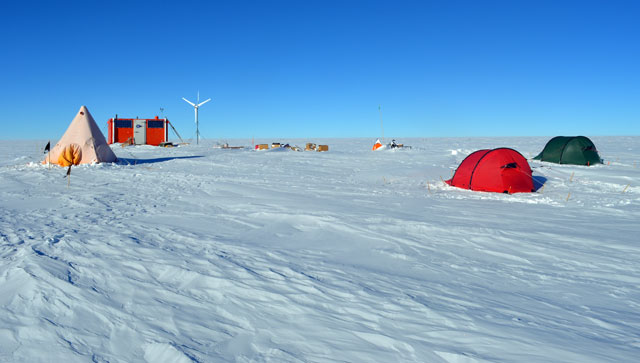|
Latest and greatestPolar Technology Conference shares advances for work in extreme environmentsPosted April 27, 2012
A unique gathering of polar veterans met in Fairlee, Vt., for the eighth annual Polar Technology Conference The conference brings together engineers and polar scientists to exchange information on the latest research needs and technology solutions that have been successful in polar environments. The topics of power and communications always top the list. Speakers talked about the requirements for remote, automated data collection stations such as the large Automated Geophysical Observatories (AGO) These stations are typically powered by a mix of solar and wind generation, with a complex battery backup system to ensure operation for one or more years between site visits. One particularly vexing issue for the Arctic remote stations has been to “bear-proof” the cable connections and other components. So far, animal damage has not been an issue in the Antarctic. 
Photo Credit: Peter Rejcek/Antarctic Photo Library
The South Pole Traverse staged on the sea ice near McMurdo Station.
Other topics involved larger infrastructure issues. This year’s presentations included a talk by David Blake of the British Antarctic Survey (BAS) The National Science Foundation (NSF) Another significant topic is transportation. Both the Arctic and Antarctic programs rely on tractor trains to supply inland stations. There are many similarities between the Greenland Inland Traverse (GrIT) and the South Pole Traverse (SPT), but there are also many differences due to terrain, weather, altitude, snow and crevasse issues. The GrIT operation has had to deal with an increasingly vexing crevasse field near the coast, while the SPoT train has had to overcome large crevasses in the shear zone near McMurdo Station Smaller vehicles were also a topic. The Arctic program supports the SAE Clean Snowmobile Challenge Another vehicle discussed at the conference was Yeti, a small ground vehicle developed at Dartmouth College Other technical topics this year included design and deployment of ocean buoys in the Arctic; drilling through Antarctic ice; exploration of subglacial lakes and ocean areas with autonomous unmanned vehicles; helicopter and ground reconnaissance of crevasses in Greenland; and new equipment for milling snow for ice road maintenance around McMurdo Station. The conference is strictly a volunteer effort led by the PTC’s Steering Committee and the annual host. Roy Stehle from SRI International The first conference was held in Mountain View, Calif., in 2005 with 31 participants. The conference has grown to include more than 70 attendees. This year’s event was sponsored by the Dartmouth College Institute of Arctic Sciences |



For USAP Participants |
For The Public |
For Researchers and EducatorsContact UsU.S. National Science FoundationOffice of Polar Programs Geosciences Directorate 2415 Eisenhower Avenue, Suite W7100 Alexandria, VA 22314 Sign up for the NSF Office of Polar Programs newsletter and events. Feedback Form |


